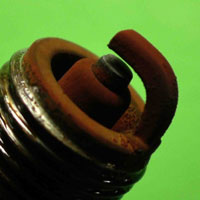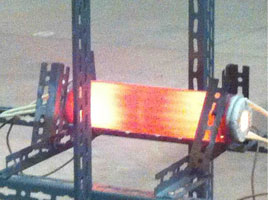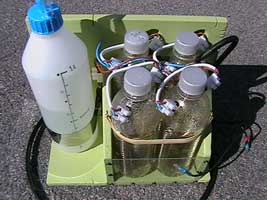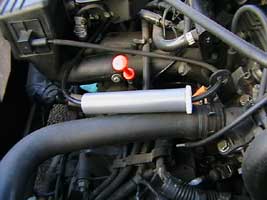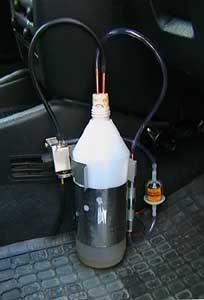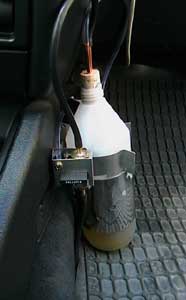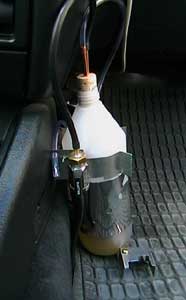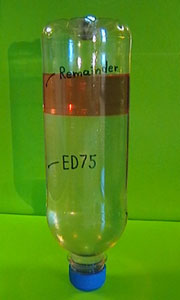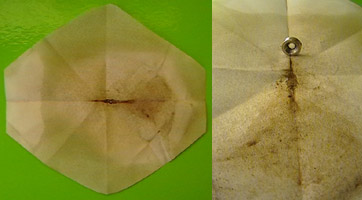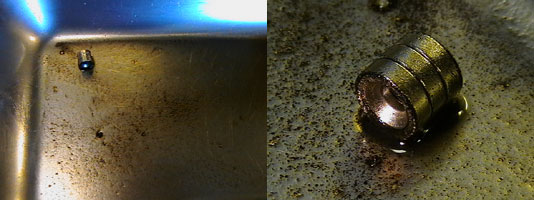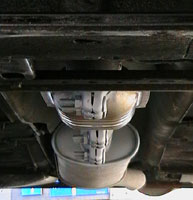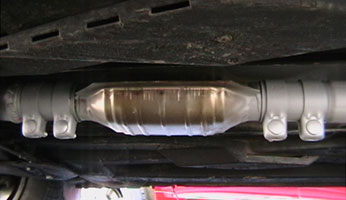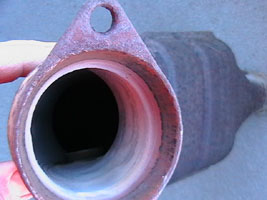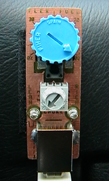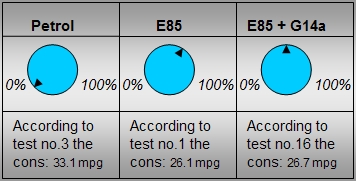Report 39 (2022-07-07):
It has not been possible to write anything here because in March 2021 I started a project that would try to find the answer to the mystery NAMAG. In June, a little more than a month ago, I finished. Many runs have been made with E85 to test all kinds of combinations of different mixtures! First I did driving tests with old and discarded G+ (the red glycol the Swedish Biltema sold in the past plus HMTA). It worked very well! Then it worked even better when I realized that the amount of lighter fluid is important (it would be reduced slightly). The newcomer kerosene is now part of what is called AT. The result of the project is AT and AG. These new fuel additives are so sophisticated that they eradicate all previous glycol additives plus some other ones that have emerged over the years. We are talking about gasoline and E85 and the mixtures between them. I'm almost certain that AT and AG are the answer to what NAMAG (Naphtha Alcohol Mix Adapted Glycol) really is and it has nothing to do with the lambda probe.
ATAG
None of this is a secret. At first, I thought about keeping SG or T50 secret so that I myself could benefit from the work I put into developing this. I am especially pleased with SG, it is a sophisticated intermediate additive but has become difficult to realize due to the outgoing glycol type. Just at the end when I started to get ready and test drives with the measuring car were carried out, everything changed.
It turned out that untouched E85 from Circle K and Qstar (Swedish trade) could perform record low consumption figures! You can read about this under Test Series 2-3. As I understand, a change of E85 has taken place at some point during the development work. That was the confirmation I asked for because things went badly in the end. AT and AG had stopped doing their job. So today, above all, AG is a meaningless fuel additive. AT, which paves the way for AG to function fully, but which alone has a certain opening time-reducing effect, can now only contribute with a certain lubrication input (of fuel pump and injector) - that's all..
But this is good! Now you do not have to slab with any additives anymore. Everything is already fixed and finished, by the companies. I have no knowledge of what happened to my measuring car - showing such good results? I guess the fuel is better, but in which way - I do not know.
Due to this overall development work, everything here has been redone. Some things have not changed such as D66, T66, A40, and ISO because they work as they should. The acetone still has its status and IPA sits like a slap in the diesel, etc. If you get a little sentimental, there is still the possibility of taking a round in the old material - it will not disappear.
In terms of news - it is the Alkylate Method that must be published (after ATAG). AM is the new way to measure ethanol content. It
is an accurate and frugal method that is now predominant, period. Apart from the extreme price increases for motor fuels - the price of E85 always follows the
price of gas slavishly - it has emerged that the ethanol content of E85 only went stranger and stranger. Today you get E90 in November or E75 in June! I write
“you get” because that's what happens. People refuel their vehicles without knowing a shit about what is coming out of the pump. I see no advantage
in switching between E85 and E75. Firstly, it no longer works - everything between E70 and E85 is approved. Why not steer this up and tighten the standard?
My suggestion: sell only E85 ±0.5% all year round. On the one hand, today's cars are better at handling high ethanol levels, and on the other hand,
those who drive tuned can continue to refuel E85 without risking an engine breakdown. As it looks now - refueling E85 is the last thing a car owner of a tuned
car wants to do. Instead, they choose C85 which is an expensive product but which does not change Willy-nilly.
The ethanol content is so poorly managed that one may wonder if there is any kind of conspiratorial plan behind the sale of E85? People
avoid refueling E85. On the one hand, it is illogically expensive, and on the other hand, it varies indefinitely. When it comes to gas, they are careful with
the ethanol content, because it does not vary between type 5 or 15 percent, or does it? In that case, maybe 98-octane (RON) gasoline also varies, right? Well,
it's probably only E85 that applies. It seems that it has been decided that E85 is a playhouse that can be varied endlessly. According to the new figures
regarding consumption, the difference between gas and E85 is 20%, instead of 32% as it was before. So if the gas price is 20 SEK/liter, E85 should cost a
maximum of 16:67 SEK/liter - but that is not the case. If they decide to lock in E85 and lower the price to a reasonable level, more car owners will choose
ethanol. Add to that, all tuned racing vehicles will probably also go from expensive C85 to regular E85. As it looks now, the vehicle owners who drive on E85
must risk their tuned engines and pay more than those who choose gasoline.
2019 was the year when my car (Peugeot 407 SW) had unexpected engine stops here and there. It started in November 2018, it was difficult to start. I jerked and pulled in various cables and exercised both contacts and fuses, wherever they could be accessed. I got an alarm on the ignition cartridge and the EGR valve. I serviced the EGR valve and bought a new ignition cartridge. It seemed to cure the problems but soon it became the same error again. I talked a lot with Appelskogs Bil (Swedish trade) in Linkoping. They thought I was rebuilding the car's electrical system too much. One day in spring 2019 I started troubleshooting the fuel pump relay because I read online that a Briton had similar problems (it was the fuel pump). To my surprise, I could see that the pump relay was burnt out. I then fixed a bypass (a relay in parallel). Then the car worked again and the error codes disappeared immediately. Later I went to Stockholm on a visit. When I approached Tantolunden the engine started to hack and it was on the verge of engine stop (think even the engine stopped once). I went to TL and thought about how to get home. Later in the evening I took a chance and drove straight home. I had the engine stopped at regular intervals but the car always started again. When I approached Motala, I constantly had engine stops but I made it. Tear up the fuel pump. I had to cut open the threaded plastic lid (sat as molded). The entire pre-filter was covered with what looked like rust. The engine simply did not get enough fuel due to a clogged pre-filter. There is no external fuel filter on this car model. The fuel line goes directly to the injectors from the pump. The fuel filter itself is an integral part of the fuel pump housing. If the filter is bad - replace the pump! Thus, the very cause of all these problems was due to ancient sins. The experiments with FeTA that were performed around 2017 were the reason. Slowly but surely, the iron residues in the tank were concentrated in the fuel pump, and then it was clogged.
2017 was also the year when I built a screen for the grille, to reduce the amount of cooling air. The engine warmed up faster then. In addition, I was able to build an electric speed-controlled fan for the air intake, I still use the fan. You can read about what happened in Stockholm in June 2021 if you go to Test Series 2-2. It was a very clear alarm clock - for hell's sake, do not clog the grille if there is a summer climate!
Ny Teknik
I used to read this magazine but it rarely happens nowadays. Sometimes it says something exciting but usually, it is the same shit that is repeated over and
over again. People have begun to understand that this rag has an agenda - that people should be guided to think in a certain way. They avoid looking at the
energy problem unconditionally, but instead they push in a certain direction. And what direction is it? It is, of course, the one that MSM trumpets daily to all
of us, that electric cars is the future, that wind power, and solar power are preferable instead to nuclear power, that hydrogen is bad, that not only cars
but all vehicles should be powered by batteries, such as trucks, buses, tractors, construction machinery, and even boats and planes... Sometimes they are forced
to write about hydrogen and if someone thinks that's good - then the Tesla patrol must pull out and neutralize the discussion. As soon as you open the magazine,
you are bombarded by a new electric car advertisement...The problem is that the equation does not add up. At the same time as all this electrification is to be introduced, nuclear plants after
nuclear plant are being shut down…
QUICK MENU
 38
38
 37
37
 36
36
 35
35
 34
34
 33
33
 32
32
 31
31
 30
30
 29
29
 28
28
 27
27
 26
26
 25
25
 24
24
 23
23
 22
22
 21
21
 20
20
 19
19
 18
18
 17
17
 16
16
 15
15
 14
14
 13
13
 12
12
 11
11
 10
10
 09
09
 08
08
 07
07
 06
06
 05
05
 04
04
 03
03
 02
02
 01
01




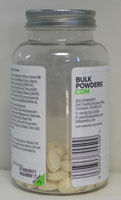
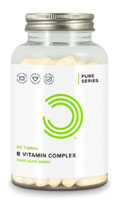
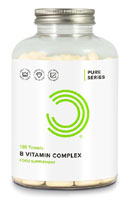
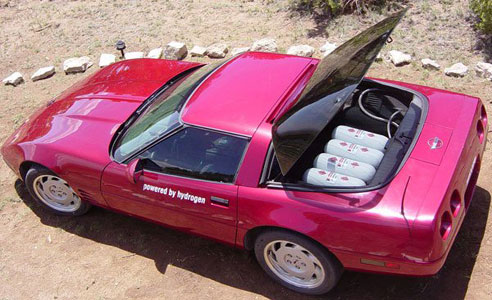


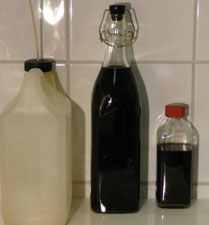 Some bottles of glass are excellent during the separation process - here A20 (1200ml).
Some bottles of glass are excellent during the separation process - here A20 (1200ml).